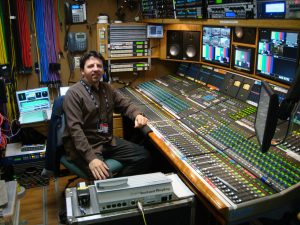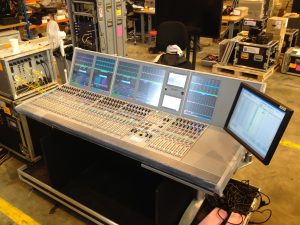Calrec A1 Spotlight With Audio Mixer Mark Butler
Story Highlights
1. How did you get your start in audio mixing?
 My journey into audio was more organic in that my knowledge and expertise was initially derived solely from first-hand experience. I decided early on that college was not the right path for me, and so I got a job at a plastics factory working the graveyard shift. A few days before I was supposed to start, I had plans to meet my friends at a concert about 90 minutes away. My car had broken down, so I decided to hitchhike. I got picked up by the bass player and when we arrived at the venue he asked me if I needed a job. It sounded better than the factory, so I went for it. I remember going around with a pad of paper and tracing every wire and then asking all these questions. For the next few years I worked my way up the ladder working for bands, sound & lighting companies and promoters. Through this I learned systems, lighting and ultimately sound. My roommate was a sound mixer, so he initially taught me to mix.
My journey into audio was more organic in that my knowledge and expertise was initially derived solely from first-hand experience. I decided early on that college was not the right path for me, and so I got a job at a plastics factory working the graveyard shift. A few days before I was supposed to start, I had plans to meet my friends at a concert about 90 minutes away. My car had broken down, so I decided to hitchhike. I got picked up by the bass player and when we arrived at the venue he asked me if I needed a job. It sounded better than the factory, so I went for it. I remember going around with a pad of paper and tracing every wire and then asking all these questions. For the next few years I worked my way up the ladder working for bands, sound & lighting companies and promoters. Through this I learned systems, lighting and ultimately sound. My roommate was a sound mixer, so he initially taught me to mix.
2. Please tell me about your background and your career, including notable and favorite projects or any awards you have won for your work. What’s the biggest audio project you have worked on in your career?
After working in the industry for a few years, I decided to go back to school. Back then there were very few programs that focused on audio and/or music. I really wanted an engineering degree and finally found Ohio State. One of the professors had his doctorate in electrical engineering, was an audiophile, a jazz musician and his best friend had a commercial recording studio. He hand-tailored a small group of us and I graduated with a BSEE degree in Electrical and Acoustical Engineering.
I continued to work concerts through school and when I graduated worked my way up to chief engineer of the largest sound and lighting company in the Southeast US. From there I worked for a mobile recording studio doing live albums/CD’s, broadcast mix downs and award shows. My partner in the recording studio was a race car fan and would work car races including Daytona, Sebring, etc. That was where I was introduced to sports broadcasting.
In my music career, I have been very fortunate to mix and work with a wide variety of artists and genres. From the Rolling Stones, U2, and Prince to Johnny Cash, Frank Sinatra, the Royal Philharmonic Orchestra and Whitney Houston, with whom I recorded “I Will Always Love You,” which sold 45 million copies and won two GRAMMYs. Not bad for a last-minute recording that we had to be talked into doing (but that’s another story). I’ve also been awarded a couple platinum albums along the way as well.
In my sports broadcasting career, I have mixed every major sport there is and have travelled all over the world doing it. We took the Fox NFL pregame show to Kabul Afghanistan, which I mixed on a Calrec Zeta. I’ve worked six Olympics (most for NBC), 17 Super Bowls (I think), five World Series, two Stanley Cups, Cricket matches, NASCAR, Indy Car Racing, Goodwill Games in Russia, Great Outdoor Games, X Games, Golf’s U.S. Open, PGA Championships, and 25 consecutive years of MLB and NFL games. During the 2008 Olympics in China, I wrote a book “Beijing Journal: A Live, Day-By-Day Account From Backstage At The 2008 Olympics.” I’ve won 11 Emmy awards and was awarded a Congressional Patriot of the Year Award for my efforts.
It’s impossible for me to pick one show or event that was my favorite or even the biggest. I feel very fortunate to have worked a lot of amazing shows with amazing people. Many were very challenging and difficult but it’s what I love and I have a lifetime of memories to go with it.
 3. How have you seen audio technologies evolve over your career? Where do you see audio mixing heading into the future?
3. How have you seen audio technologies evolve over your career? Where do you see audio mixing heading into the future?
We’ve gone through many major transformations in my career. Of course, the easy answer is mono to stereo to digital and surround and now were embarking on immersive. I’ve had to reinvent myself at least once every decade. There’s never a dull moment in remotes, especially working for cutting-edge broadcasters since the latest and greatest electronics are not always the most stable. Immersive or Dolby’s Atmos is definitely the next step in live remotes. It’s being fully implemented in episodic series and movies but it’s just starting to be explored in live events. Since the designer or mixer has 128 object-based tracks at their disposal along with location and pan, every show can be tailored individually. There is no limit to the creativity that can be deployed. It’s very exciting to think of the possibilities of how and where it will be used.
4. You also work at Fox Sports and NFL Network. What types of events do you work on? What does your job as a Senior Audio Engineer entail?
This year will be my 25th year working with Fox for the NFL. I have done all their sports and events since their inception including MLB, NHL, USGA U.S. Open, World Series, and Super Bowls. I’ve been the audio consultant and senior remote engineer for the NFL Network since about 2012, doing NFL games and Super Bowls, The NFL Draft, Combine, and Hall of Fame inductions, among others. As a senior engineer the buck stops with me. I pick the audio crew and work with production and technical staff to come up with a game plan and then form an engineering plan augmenting the remote facilities with whatever rental gear is needed to mix the show.
5. When did you first start using Calrec?
I first used Calrec in the 90’s with the S and Q Series desks in NEP trucks. In that day, there were a plethora of different consoles in trucks. I loved the studio boards but they all had that recording studio flow so you couldn’t use upper and lower faders to send to the same sources. The Q was the first desk that broke that mind-set; I loved it! When desks first started going digital there was a trend among manufacturers to use less faders and my line to them all was I want a digital Q with no restrictions in routing.
In 2002 I had the first Alpha in the states in the NEP SS9 for the Super Bowl Pregame in New Orleans.
In 2004, I mixed my first Super bowl in surround and I had a Calrec Q Series console. I remember using popsicle sticks taped to 4 faders for my surround channels. The different kinds of faders had different color knobs and I’d pull them off and move them all over the desk, the red ones were for the most important channels. We took a Vision flight pack to Afghanistan with a Zeta console and it was flawless.
6. What Calrec Audio consoles do you use? Why do you choose to mix with Calrec?
I would say 98 percent of my shows use Calrec consoles. The Apollo is my favorite. The horsepower, resources, and most importantly the sound is fantastic. It’s an incredibly responsive desk and the Hydra2 system with the networking capabilities is unparalleled. I don’t think I could do some of my shows without an Apollo or at least I wouldn’t want to. I think Calrec has taken that “British sound legacy” to another level.
7. What has the console technology allowed you to do today that would not have been possible when you started?
It’s really apples and orangutans from then to now (oranges are too close). When I started with sports broadcasting, I did every sport there was on a 16 channel Yamaha with four groups and four auxes. I do shows now using all 144 faders on my Apollo, all 96 multitracks, 36 auxes, 12 groups, and I’m still 4 or 5 layers deep. Back in the day we used telephone wire for car racing and golf, now it’s fiber with Hydra2s everywhere. It wasn’t possible to network the consoles and share resources. Now, we tie 10+ consoles together with 30+ Hydra2s, no problem. We are so spoiled now.
